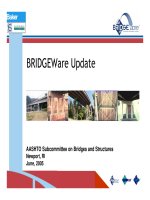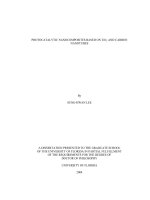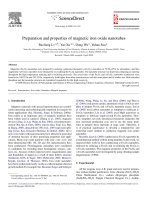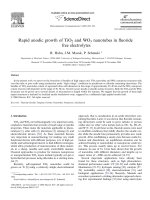- Trang chủ >>
- Khoa Học Tự Nhiên >>
- Vật lý
nanotubes and nanocones
Bạn đang xem bản rút gọn của tài liệu. Xem và tải ngay bản đầy đủ của tài liệu tại đây (2.71 MB, 32 trang )
Steffen Weber's
Crystallography
Picture Book
02
Nanotubes & Nanocones
Preface
This is the first in a series of picture books that I plan to create for educational purposes. All
images in this volume were created using the program NanotubeModeler from JCrystalSoft. A
free version of this program can be downloaded at www.jcrystal.com. My earliest
implementation of routines for the creation and visualization of nanotubes and nanocones was
realized in JSV (Java Structure Viewer), a program which I wrote while working at NIRIM in
Japan. Later I wrote a Java Applet version on the request of Dr. Jeremy Sloan. This year I
finally wrote NanotubeModeler as a stand-alone Windows application on the request of my
former collegue Dr. Paul Dennig who is now working for Ahwahnee Technology. The nano-
geometries are created by first generating a flat graphene sheet and then rolling it into a tube or
a cone. Two types of nanotubes can be capped with parts of the well-known Buckyball (C
60
).
These are the {5,5} and the {9,0} tubes, which have a suitable diameter of about 6.9 Å.
Nanotubes are identified by their chiral indices {m,n}. One distinguishes between armchair
structures (n=m), zig-zag structures (n=0) and chiral structures. Nanocones are characterized by
the disclination angle, which corresponds to the part that is removed from the flat sheet before
rolling it into a cone.
Steffen Weber, Ph.D.
December 10, 2004
Livermore, California
www.jcrystal.com/steffenweber
Capped {5,5} Tube
Carbon Nanotube
Armchair structure with Bucky-ball caps
Capped {5,5} Tube
Carbon Nanotube
Armchair structure with Bucky-ball caps
Length ~25 Å, Diameter ~6.75 Å
Capped {9,0} Tube
Carbon Nanotube
Zigzag structure with Bucky-ball caps
Capped {9,0} Tube
Carbon Nanotube
Armchair structure with Bucky-ball caps
Length ~25 Å, Diameter ~6.99 Å
Inside Capped {9,0} Tube
Inside a capped {9,0} nanotube
Bucky-Ball (C
60
)
A Buckyball, the well-known Fullerene with icosahedral symmetry. Two different
sections of the Buckyball can be used to cap the {5,5} and {9,0} nanotubes.
{10,0} Nanotube
Zig-zag structure
Length ~19 Å, Diameter ~7.77 Å
{10,10} Nanotube
Armchair structure
Length ~25 Å, Diameter ~13.465 Å
{10,0} Graphene Sheet
Zig-zag structure
This sheet can be rolled into a {10,0} nanotube
{10,10} Graphene Sheet
Armchair structure
This sheet can be rolled into a {10,10} nanotube
{14,5} BN-Nanotube
Chiral Boron-Nitride nanotube
Length ~30 Å, Diameter ~13.26 Å
{14,5} BN-Sheet
Chiral structure
This sheet can be rolled into a {14,5} nanotube
Inside {14,5} Nanotube
Inside a bent {14,5} nanotube
MWCNT
A multi-walled carbon nanotube (MWCNT)
{7,0}, {10,0}, {13,0} and {16,0} tubes
{7,0} Nanotube Bundle
A bundle of seven {7,0} single-walled carbon nanotubes (SWCNT)
{7,3} Nanotube Bundle
A bundle of seven {7,3} nanotubes
Inside {5,3} Nanotube
Looking inside a bundle of {5,3} nanotubes
60° - Nanocone
Disclination angle 60°
Cone height 20 Å
60° - Nanocone Sheet
Disclination angle 60°
Creates a cone of height 20 Å
120° - Nanocone
Disclination angle 120°
Cone height 30 Å
120° - Nanocone Sheet
Disclination angle 120°
Creates a cone of height 20 Å
180° - Nanocone
Disclination angle 180°
Cone height 30 Å
180° - Nanocone Sheet
Disclination angle 180°
Creates a cone of height 20 Å









